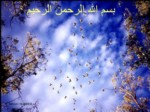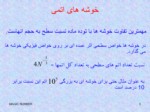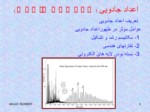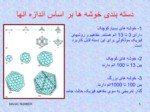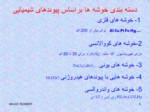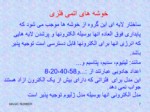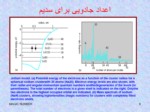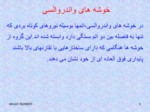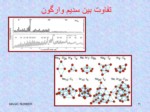بخشی از پاورپوینت
--- پاورپوینت شامل تصاویر میباشد ----
اسلاید 1 :
تعریف اعداد جادویی
عوامل موثر در ظهوراعداد جادویی
1- مکانیسم رشد و تشکیل
2- تقارنهای هندسی
3- بسته بودن لایه های الکترونی
اسلاید 2 :
1- خوشه های بسیارکوچک
دارای 3 تا 13 اتم هستند. مفاهیم و روشهای فیزیک مولکولی برای این دسته قابل کاربرد است.
2- خوشه های کوچک
بین 13 تا 100 اتم دارند
3- خوشه های بزرگ
بین 100 تا 1000اتم دارند.
گذار تدریجی به سوی مفاهیم فیزیک حالت جامد
اسلاید 3 :
دسته بندی خوشه ها براساس پیوندهای شیمیایی
1- خوشه های فلزی
برای بیش از 200 اتم Al,Cu,Pt,Fe,Hg,…
2-خوشه های کووالانسی
برای 30 تا 80 اتم C,Si,Hg مانند : SP دارای هیبریداسیون
NaCl,CaBr2,… 3- خوشه های یونی
Hf,H2O 4- خوشه هایی با پیوندهای هیدروژنی
5- خوشه های واندروالسی
اسلاید 4 :
ساختار لایه ای این گروه از خوشه ها موجب می شود که پایداری فوق العاده انها بوسیله الکترونها و پرشدن لایه هایی که انرژی انها برای الکترونها قابل دسترسی است توجیه پذیر باشد.
مانند: لیتیوم، سدیم، پتاسیم و...
اعداد جادویی عبارتند از :...و8،20،40،58
این مدل برای فلزاتی که دارای بیش از یک الکترون ازاد هستند جواب نمی دهد.
مدل الکترونی انها بوسیله مدل ژلیوم توجیه پذیر است
اسلاید 5 :
در خوشه های واندروالسی،اتمها بوسیله نیروهای کوتاه بردی که تنها به فاصله بین دو اتم بستگی دارد وابسته شده اند.این گروه از خوشه ها هنگامی که دارای ساختارهایی با تقارنهای بالا باشند پایداری فوق العاده ای از خود نشان می دهند.
اسلاید 6 :
نیروی کوتاه برد واندروالس برای هر جفت از اتمها منجر به بوجود امدن می شودicosahedral بیشترین پکیدگی در ساختارهای (بیست وجهی)
اسلاید 7 :
- Atom cluster
- Clusters are aggregates of atoms (or molecules) containing
- between three and a fewthousand atoms that
- have properties intermediate between those of the
- the clusters. For example, ionic clusters such as those
- of sodium chloride [(NaCl)N] very rapidly assume the
- cubic form of the bulk crystal lattice, and for metallic
- clusters it is the electronic structure rather than
- the geometric structure which is most important.
اسلاید 8 :
- In Fig. 1, we present the mass spectra measured for Ar and Na ACs (see [1]), which clearly demonstrate the emergence of magic numbers. The forces binding atoms in these two different types of ACs are different. The argon (noble gas) ACs are formed by van der Waals forces, while atoms in the sodium (alkali) ACs are bound by the delocalized valence electrons moving in the entire AC volume. The differences in the inter-atomic potentials and pairing forces lead to the significant differences in structure between Na and Ar ACs, their mass spectra and their magic numbers.
- In Fig. 2, we present and compare the geometries of a few small Na and Ar ACs of the same size. It is clear from Fig. 2 that the principles of AC organization are different for the alkali and noble gas families. Such differences can easily be explained. The van der Waals forces lead to enhanced stability of AC geometries based on the most dense icosahedral packing. The the most prominent peaks in mass spectra of argon ACs correspond to completed icosahedral shells of 13, 55, 147, 309 etc. atoms. The origin of the sodium AC magic numbers is different. In this case the AC magic numbers 8, 20, 34, 40, 58, 92 etc. correspond to the completed shells of the delocalised electrons: 1s2 1p6 1d10 2s2 1f14 2p6 etc.. This feature of small metal ACs make them qualitatively similar to atomic nuclei for which quantum shell effects play the crucial role in determining their properties [5].
- The enhanced stability of AC systems can be characterized by computing the second differences in AC binding energies. In Fig. 3, we present the second differences in Ar ACs binding energies calculated in [3]. The correspondence of the peaks in Fig. to those in the Ar ACs mass spectrum shown in Fig. 1 is readily established.

